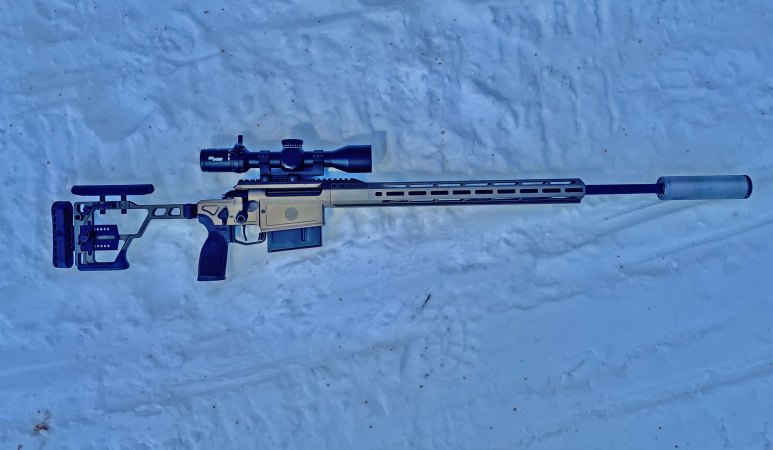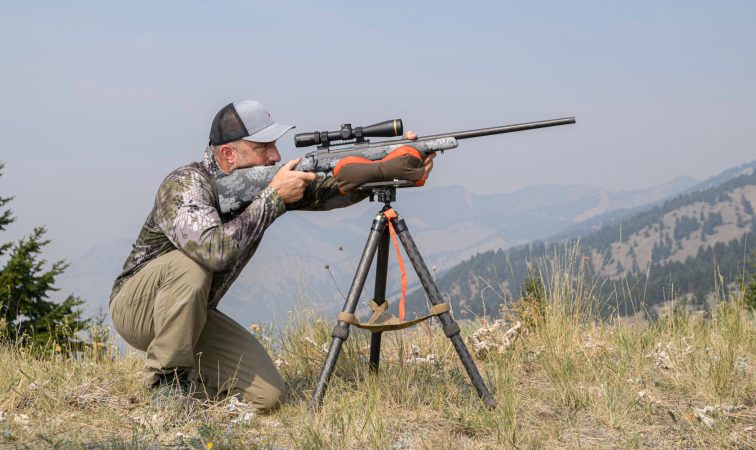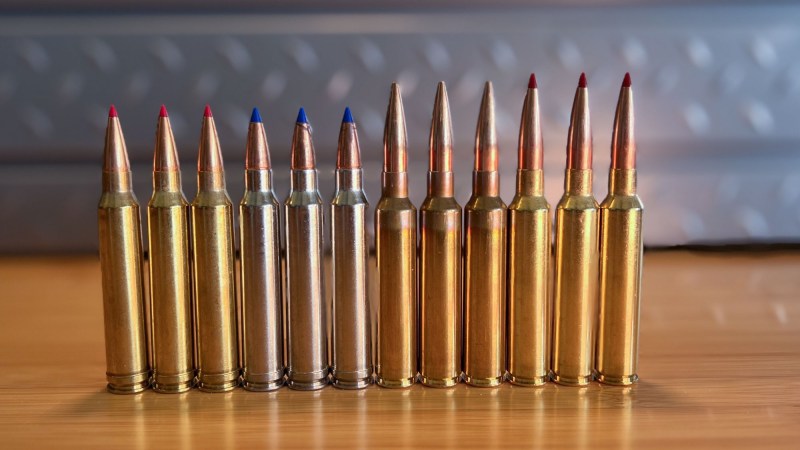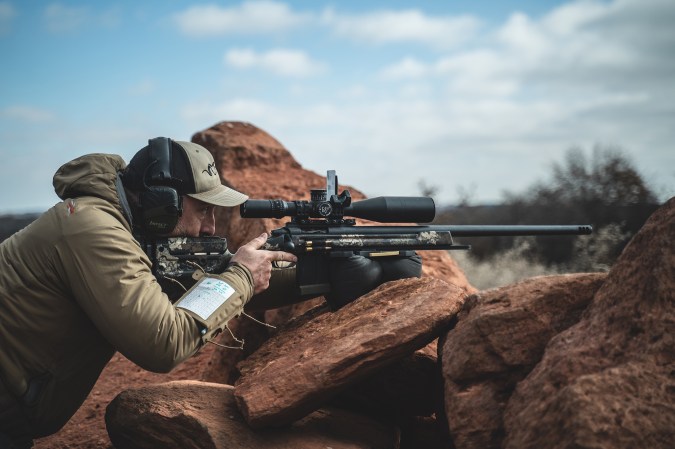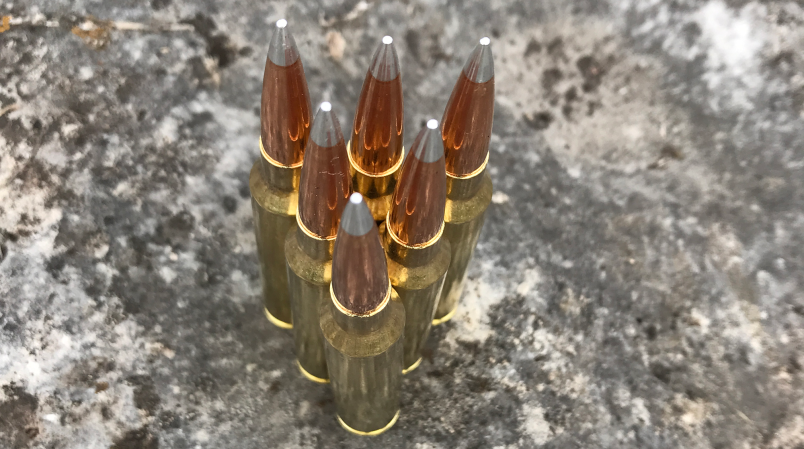We may earn revenue from the products available on this page and participate in affiliate programs. Learn More ›
To me, “you don’t know what you don’t know,” is one of the more irritating catchphrases in the English language. It’s cliché masquerading as wisdom and the people who use it tend to be self-help gurus, social media “personalities,” or know-it-alls camped at the end of the bar drinking cheap whiskey. But sometimes it hits the mark — and in this instance it provides good context to understand the latest news in the world of long-range shooting.
Our buddies at Hornady have just gone public with a significant revelation they observed and decoded several years ago concerning bullets designed for precision shooting. Cutting to the chase, they learned that bullets with a flat tip, rather than a tip that is rounded off or comes to a sharp point, are more consistent at long range.
It turns out that that little flat tip reduces the variability in the drag the bullet experiences in flight, leading to improved accuracy.
Doppler Radar: A Ballistic Hubble Telescope
Back in 2014 Hornady purchased a doppler radar system that allowed them to track the flight of the bullets in great detail. These profiles formed the basis of the library of projectiles in their excellent 4DOF ballistic app.
Unlike the old way of calculating a bullet’s ballistic coefficient (BC) by measuring retained velocity at different distances with chronographs (and only getting a handful of data points at most), the doppler radar provides continuous feedback on how the bullet flies for thousands of yards, letting Hornady calculate a data-rich drag profile. In terms of information density, it is the difference between a simple line drawing and a high-res video.
So, when they fired up their radar, they noticed all kinds of things that they never previously observed. It was like a ballistic Hubble telescope, granting access to wonders that were previously beyond our vision.

Hornady
Melting Tips: An Early Clue
One of the first things they discovered was that the plastic tips on some bullets (both theirs and their competitors’) were melting in flight. This led to Hornady’s Head Shield Technology, which was basically to use a heat-resistant polymer that would retain its shape. I summed this up in two sentences, but it took them two years to figure this out. One other tidbit that Hornady gleaned during this process was that the tips melted into a flat shape.
Magic Ratio of Meplat Diameter to Bullet Caliber: .08 to .16
If you look closely at the tip of one of Hornady’s A-Tip bullets, you’ll notice that it is flat. The same goes for the tip — technically known as the meplat — on their ELD-M and ELD-X projectiles, at least those made since 2018. Prior to that the ELD-Ms and ELD-Xs had radiused tips that were rounded off. They changed the profile on those bullets once they learned about benefits of the flat meplat, but never told anybody about it as they didn’t want to tip their hand to the competition.
To reduce drag variability, the diameter of the flat on the meplat must fall between .08 and .16 times the diameter of the bullet. (On a .308-caliber bullet this means the flat should be between .024 and .049 inches across.) If the ratio of the meplat diameter to bullet caliber is outside these parameters, the drag variability increases. To really get into the weeds on the science you can check out Hornady’s patent on Bullets with Improved Aerodynamics, which was granted in August of 2022.
(Hornady kept this under their hat because they felt no need to tip-off their competitors, but have decided to go public now to celebrate this ground-breaking innovation.)

What Is Drag Variability?
When attempting to hit a target, especially at long range, there are a lot of variables potentially working against us. Some of the factors that contribute to a lower hit probability include:
- Velocity variability (Not every bullet exits the muzzle at the same speed)
- Wind estimation error (Being off even 1 or 2 mph can have a significant effect at long range)
- Human error (Lack of consistency while handling recoil, aiming, or zeroing a rifle)
- Ammunition quality
Ammunition quality is actually a broad umbrella that covers things like how concentric a bullet is seated in the brass (if the bullet is tipped to the side that doesn’t help accuracy) and how consistently the bullet is constructed.
Drag variability is a product of bullet shape and construction. Simply put, even if we control all the factors listed above, not every bullet will fly the same way every time. Even if we take a box of perfectly formed bullets, identical to each other in every way, there will be variation in their drag as they arc downrange. What gives?

John B. Snow
Pesky Shockwaves
High-speed photography of supersonic bullets in flight (using what’s called Schlieren imagery) shows shockwaves that trail off their sides like the wake made by a boat. But unlike a boat, the shockwaves can appear in multiple places including the base of the bullet, the juncture of the ogive and the bullet shank, and the tip of the bullet.
It turns out the shockwave at the tip of the bullet is of particular concern when it comes to drag variability.
It took Hornady years to isolate the variables contributing to diminished hit probability and zero in on the shockwaves. What they discovered is that pointy bullets (like classic OTMs) and bullets with radiused tips (like the original ELD-Ms and ELD-Xs) have a shockwave that touches the tip of the bullet. The effect of that leading shockwave being connected to the bullet is greater drag variability. Sometimes the bullet will have extra drag, and sometimes it will have less. This inconsistent drag, naturally, can cause the bullet to strike somewhere other than where we were aiming.
Flat Tip Cushion
When looking at bullets with the correctly sized flat tip, the high-speed photography shows a cushion between the meplat and the leading shockwave. That cushion — the heart of Hornady’s Drag Variability Reduction Technology, or DVRT —greatly diminishes the drag variability from shot to shot.

John B. Snow
DVRT By the Numbers
Through extensive experimentation and analysis, Hornady was able to quantify the drag variability of bullets with flat tips compared to those with pointy or radiused tips.
In one test they used three different barrels with three different twist rates and three different rifling forms and put 49 shots downrange with a radius-tipped bullet and 58 shots downrange with a flat-tipped bullet.
The drag on the radiused bullet varied by as much as 12.7 percent (that was the extreme spread) and the standard deviation in drag variability was 3 percent.
By contrast, the ES of the drag in with the flat-tipped bullets was 4.4 percent, and the standard deviation was 1.1 percent. That’s a remarkable improvement.
Of course, the flat tip diminishes the bullet’s BC some, but that slightly decreased aeroballistic efficiency is minor and the benefit of better drag profile consistency more than offsets this purely theoretical downside.

Hornady
Drag Variability in the Field
If you do a lot of long-range shooting, you’ve encountered drag variability yourself. You just didn’t realize it and attributed it to something else. That shot that inexplicably cruised high or low? Probably a variation in muzzle velocity. If it went wide to the right or left, that must have been a shift in the wind. Or maybe you just had a sub-par trigger break. Who knows?
Perhaps you’ve even sub-consciously adapted to drag variability. A time-honored saying in the shooting world is “believe the bullet.” And for the most part that’s true. You might think your bullet’s BC is one thing, but if the bullet is telling you something else based on where it is hitting — believe the bullet. Or you might think the wind is acting a certain way, but if the bullet shows something else — believe the bullet.
Except after time, and under some circumstances, you learn to not believe the bullet. This is one of the skills that separates good long-range shooters from those who’ve mastered the art.
One place this manifests itself is in the heat of competition. Say you’re shooting a sniper match, and your dope has been on and you’re kicking off a new stage. You get a solid hit on the first target and move to target number two. You know you have a good range on the target, and your wind call is solid though maybe you refine it based on where you hit target one. You break the shot, and it sails high and to the left.
Intermediate level shooters, who’ve learned how to manage recoil and spot their shots, will typically make the adjustment to their point of aim — and promptly bury the next shot in the dirt low and right. Suddenly, they’ve dropped the target and must move on to the third plate, frazzled and second-guessing themselves.
Experienced shooters will recognize that something was off with that goofy shot. It takes a lot of confidence (and trigger time) to learn to ignore that anomalous result and use the same hold for the follow up shot. It becomes a matter of feel, an intuitive understanding that what the bullet did wasn’t reflective of the variables we typically worry about. Bang, impact.
In other words, we learned to account for drag variability, but just didn’t know it.
The Stealthy Nature of Drag Variability
One reason drag variability is hard to detect is that it lurks in the shadows, like a ninja, reluctant to reveal itself. It hides like this: Say we launch a bullet at a target at 1,200 yards and it has more drag on it — but spits out at a higher than usual muzzle velocity. Those two variables will cancel each other out and guide the bullet to the center of the group, and the triumphant shooter is none the wiser. The same can happen when we have less drag on a bullet and a lower muzzle velocity. They combine in an advantageous manner and the bullet stays within the expected cone of dispersion, and we have no reason to suspect anything is amiss.
It’s when the variables stack the other way around — less drag with a higher speed, or more drag at a lower muzzle velocity — that we see these “fliers” but this is only a subset of the total number of shots where the bullets’ drag variability was wonky.

John B. Snow
Witnessing Drag Variability Firsthand
I traveled to Hornady’s headquarters earlier this year with a handful of other ballistic nerds to get a look at DVRT in action. Hornady’s ballistic brain trust, which includes Jayden Quinlan, Joe Thielen, Miles Neville, and Seth Swerczek, talked us through how they figured out the issue with drag variability and prepared a demonstration for us.
With Miles behind the trigger of a 6.5 Creedmoor, they put 40 shots downrange, recording each with doppler radar and two sets of acoustic microphones that measured group sizes and retained velocities at 100 and 1000 yards.
Twenty of the shots were with older ELD-Ms with rounded tips, and 20 were with ELD-Ms of the same weight with the flat DVRT meplats. All the rounds were loaded with the same powders and charge weights on the same reloading dies and from the same lot of brass.
Not only did we eventually see one of the older ELD-Ms sail high — what would have been one of those inexplicable “fliers” back in the day — but we also saw a shot with a lower muzzle velocity that was at the bottom of the group at 100-yard group that cruised into the upper portion of the group at 1000 yards because it had significantly less drag causing it to impact higher at the longer distance. We caught the ninja.
(Another factor I’ve skipped over is the natural dispersion in any group of shots. In addition to drag variability and muzzle velocity this has a significant effect on where bullets impact.)
At the end of the experiment, we could see that the dispersion (group size) of the 20 shots with the flat meplats was much tighter and had less vertical spread than the rounds with the older bullets.
While Hornady’s in-depth technical presentation to the group prior to the demonstration was persuasive, seeing it in person sealed the deal in my eyes. The science behind, and the execution of, DVRT is legit.

John B. Snow
How will Drag Variability Reduction Technology Change Things?
One thing that’s interesting about Hornady’s patent is that it only covers tipped bullets. So any bullet with an add-on tip — whether polymer, aluminum, or some other material — falls under the patent if it is made with a flat (or flatish) meplat that falls within the DVRT ratio.
Any competitive bullet maker can make a machined-turned bullet with a flat meplat and not infringe on Hornady’s intellectual property. Likewise, one could attempt to trim the meplats on OTM bullets to give them the correct dimensions, though they would be difficult to manufacture in quantity.
I expect those who make machined-turned match bullets to start incorporating this information into their designs.
From the standpoint of the end user, I imagine more long-range shooters will gravitate toward the ELD-M and A-Tip bullets. Both bullets already have a sterling reputation in the world of long-range competition, and DVRT will give the shooter a bit more of an edge.
How much of an advantage it gives is difficult to quantify. But over the course of a two-day match that has a significant number of targets beyond 800 yards, it will probably help a skilled shooter pick up a couple extra points.
That might not sound like much, but adding three points to your match total can move a shooter up half a dozen spots in the rankings — sometimes more.
As with other new technologies that have appeared on the long-range shooting scene, I’m sure we’ll see a good portion of doubters, another chunk of cranks who will dismiss it out of hand, a significant percentage of people who don’t grasp the concept, and those for whom this innovation is not relevant. But there will also be a number of people who will get it and who will be eager to reap the benefits that come from shooting a more consistent bullet.
And for those people, DVRT is a gamechanger.
Other Resources on Drag Variability Reduction Technology
To take a deeper dive into DVRT visit Hornady’s landing page, which has an explanatory story and links to a series of videos as well as a podcast on the topic.






